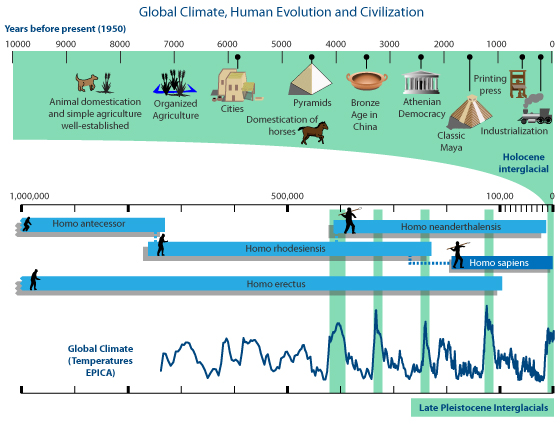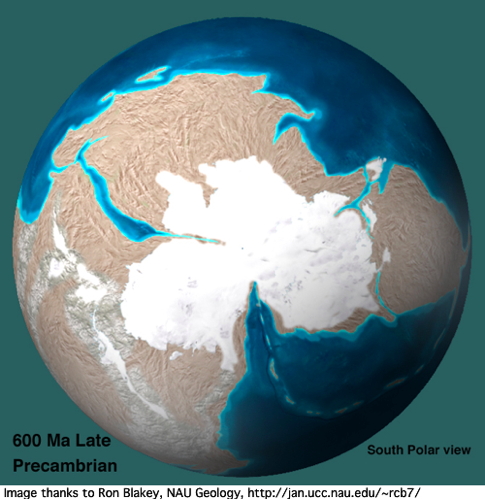We've been through climate changes before
Posted on 9 March 2012 by Sarah
This is the basic rebuttal to 'Humans survived past climate changes'
Humans have been through climate changes before- but mostly cold ones and mostly in our far distant past.
"Yes, our climates change. They've been changing ever since the Earth was formed." Rick Perry
Previous major global climate changes were glacial cycles that happened long before human civilization developed.
The human species evolved during the last 2.5 million years. Our far distant ancestors survived through multiple gradual cycles of cold ice ages, but did not experience any previous "hot ages."
We Homo sapiens in our current form appeared only about 200,000 years ago. So our species has survived two ice ages. In each ice age global temperatures were colder by 4 °C. The warmest period ever experienced by early humans was about 1 °C warmer (global average) than today. That period occured between the two most recent ice ages, 120,000 years ago (Eemian). Over the next 100,000 years temperatures gradually decreased into a new ice age. During that colder period humans began to expand out of Africa and across the globe. Ever since the Eemian much cooler temperatures have been the norm.

Image by John Garrett.
Human civilization is roughly 12,000 years old, as defined by the start of permanent settlements and agriculture. Agriculture became established as the glaciers retreated from the last ice age. Modern society has developed entirely in our current geological epoch, the Holocene. Global temperatures haven't varied by more than ±1 °C since. There have been regional shifts in climate (Medieval Warm Period, Little Ice Age, etc), but since civilization began humans have never experienced a hotter global climate than now.
Going back further, over a million years or so, our pre-human predecessors experienced a series of long cold glacial cycles. Several short interglacial periods were as warm or slightly warmer than our current climate. For example, the climate 400 kyrs ago, was slightly warmer than now. But more typically for the last million years it's been 4 to 8 °C colder. Each transition from warm to glacial ages and back took thousands of years, giving humans and prehumans many generations to adjust.
So, really, the climate hasn't changed much since we settled into towns, invented plumbing, and started calling ourselves civilized.
Since humans and our human ancestors have been on Earth, average global temperatures have never been 3 °C warmer than now. In the next 100 years our children will be the first people ever to experience that kind of climate.
But, perhaps Mr. Perry is thinking he'd like to live in a climate eons ago, closer to when the Earth was formed.

Digging way back in time, we know that Earth's climate has certainly been very different than it is now: 2 billion years ago there was not even any oxygen in the atmosphere. 550 million years ago high CO2 levels caused extreme greenhouse conditions. Humans were not around to care; the most advanced life form at that time was a flatworm. Humans could not physically survive over most of the planet in the age of the dinosaurs (Cretaceous, 100-65 Myr ago). Only very small mammals were beginning to evolve. Global average temperatures were 10-12 °C hotter than today. Most places on land were so hot that humans would risk fatal heat stroke every summer.
The geological record shows many ancient changes in climate, including massive ice ages, hot-house conditions, oxygen-free and acidic oceans, and massive extinction events. These changes happened millions of years before humans, most occurred before even primitive mammals, appeared on the scene. Previous climate changes were caused by orbital wobbles, solar fluctuations, and movement of continents. None of those effects are causing the current heating http://sks.to/past.
References (added 2012-03-11)
Breecker, D. O., Sharp, Z. D., & McFadden, L. D. (2010). Atmospheric CO2 concentrations during ancient greenhouse climates were similar to those predicted for A.D. 2100. Proceedings of the National Academy of Sciences, 107(2), 576–580. doi:10.1073/pnas.0902323106.
Ron Blakey, Global Paleogeography maps: http://jan.ucc.nau.edu/rcb7/globaltext2.html
Glikson, A. (2008). Milestones in the evolution of the atmosphere with reference to climate change. Australian Journal of Earth Sciences, 55, 125–139.
Hansen, J. E., & Sato, M. (2011). Paleoclimate Implications for Human-Made Climate Change. Arxiv preprint arXiv:1105.0968.
McInerney, F. A., & Wing, S. L. (2011). The Paleocene-Eocene Thermal Maximum: A Perturbation of Carbon Cycle, Climate, and Biosphere with Implications for the Future. Annual Review of Earth and Planetary Sciences, 39(1), 489–516. Annual Reviews. doi:10.1146/annurev-earth-040610-133431.
Sherwood, S. C., Huber, M., (null), & (null). (2010). An adaptability limit to climate change due to heat stress. Proceedings of the National Academy of Sciences of the United States of America, 107(21), 9552–9555. doi:10.1073/pnas.0913352107.
Ulrich C. Müller, (2009) "EEMIAN (SANGAMONIAN) INTERGLACIAL". p 302, in: Encyclopedia of paleoclimatology and ancient environments. editor, Gornitz, V. Springer Verlag.































 Arguments
Arguments























 0
0  0
0 --source
Anthropocene climate change will push us out of that comfort zone, much to our peril.
--source
Anthropocene climate change will push us out of that comfort zone, much to our peril.







Comments